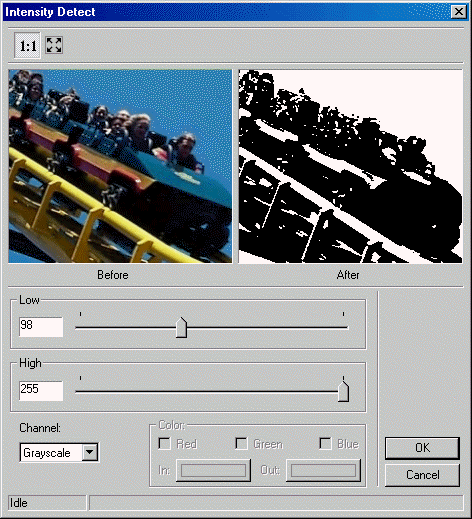
LDialogColor::DoModalIntensityDetect
#include "ltwrappr.h"
virtual L_INT LDialogColor::DoModalIntensityDetect(hWndOwner)
|
HWND hWndOwner; |
/* handle of the window which owns the dialog */ |
Displays the Intensity Detect dialog box, and gets the options for LBitmap::IntensityDetect.
|
Parameter |
Description |
|
hWndOwner |
Handle of the window which owns the dialog. |
Returns
|
SUCCESS_DLG_OK |
The "OK" button was pressed, and the dialog exited successfully. |
|
SUCCESS_DLG_CANCEL |
The "Cancel" button was pressed, and the dialog exited successfully. |
|
< 1 |
An error occurred. Refer to Return Codes. |
Comments
LDialogColor::SetIntensityDetectParams must be called before using this function to set the initial values for the dialog. You can get the updated INTENSITYDETECTDLGPARAMS with the values entered by the user through the dialog by using LDialogColor::GetIntensityDetectParams.
The Intensity Detect dialog is shown in the following figure:

Required DLLs and Libraries
|
LTDLGCLR For a listing of the exact DLLs and Libraries needed, based on the toolkit version, refer to Files To Be Included With Your Application |
See Also
|
Functions: |
|
|
Topics: |
Example
void TestFunction(LBitmap * pBitmap, HWND hWnd)
{
LDialogColor DlgColor;
DlgColor.Initialize(DLG_INIT_COLOR );
DlgColor.SetBitmap(pBitmap);
INTENSITYDETECTDLGPARAMS DlgParams;
memset ( &DlgParams, 0, sizeof ( INTENSITYDETECTDLGPARAMS ) ) ;
DlgParams.uStructSize = sizeof ( INTENSITYDETECTDLGPARAMS ) ;
DlgParams.uChannel = IDB_CHANNEL_MASTER ;
DlgColor.EnableCallBack(FALSE);
DlgColor.EnablePreview(TRUE);
DlgColor.EnableAutoProcess(TRUE);
DlgColor.EnableToolbar(TRUE);
DlgColor.SetIntensityDetectdParams(&DlgParams) ;
DlgColor.DoModalIntensityDetect(hWnd);
// Gets the updated values for the structure
DlgColor.GetIntensityDetectdParams(&DlgParams, sizeof(DlgParams)) ;
DlgColor.Free();
}